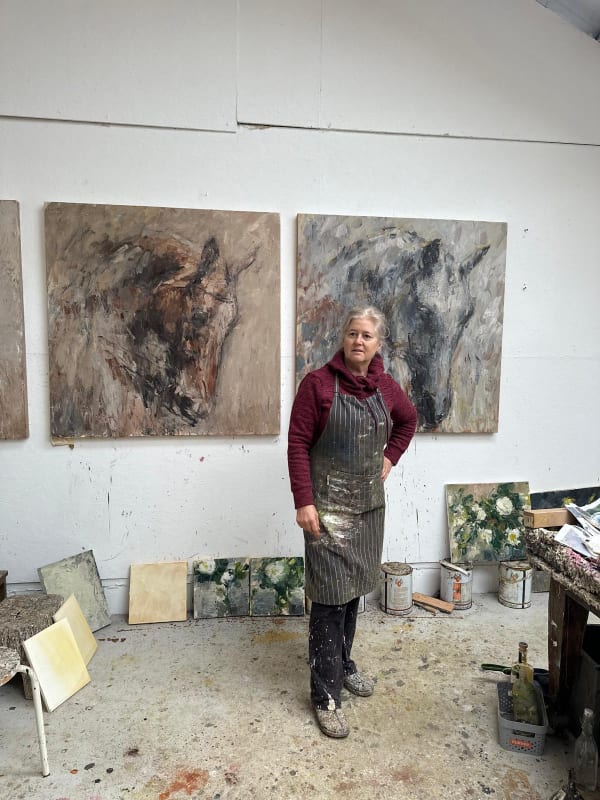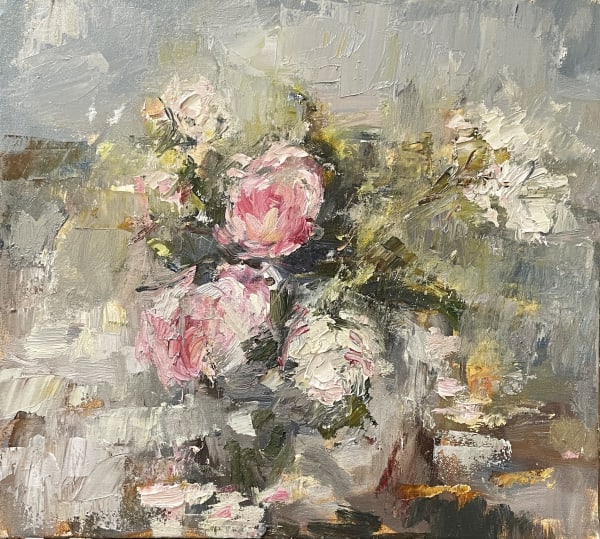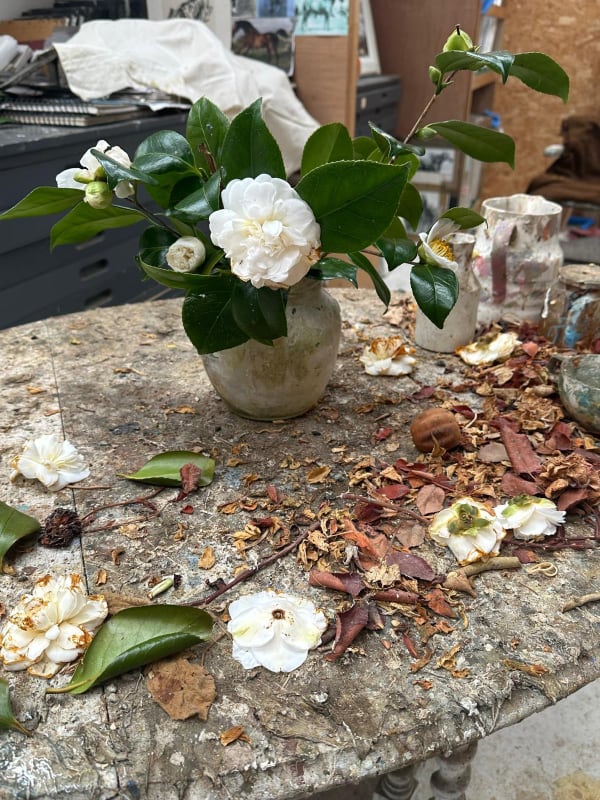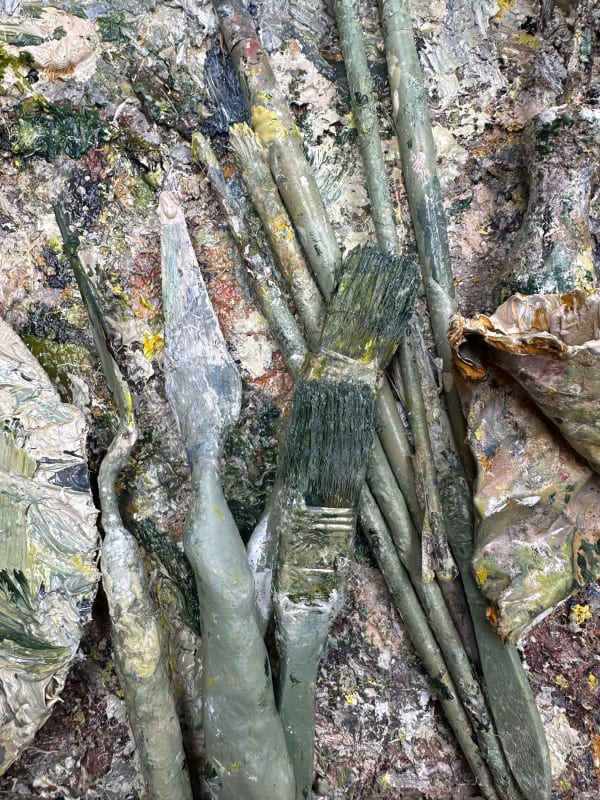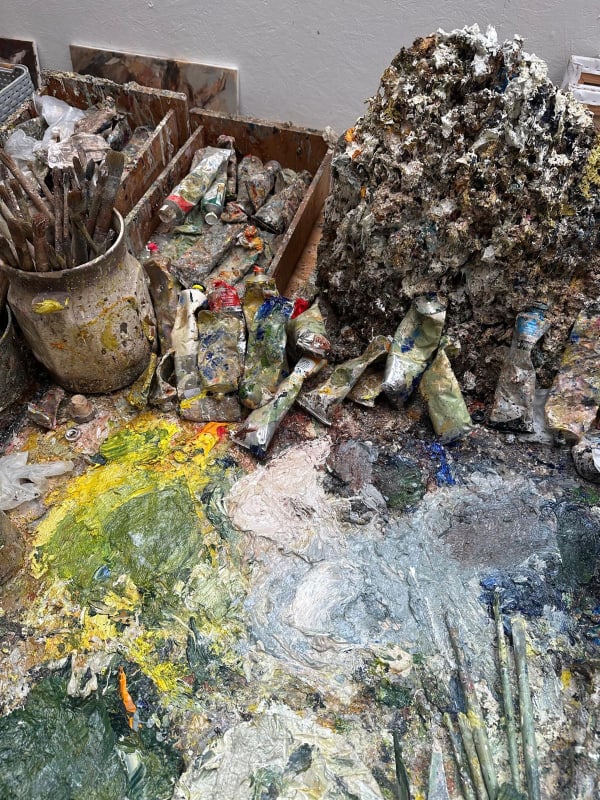Flowers, like the landscape, are not static, they change as the flowers wilt and drop their petals. Life is transient. I learn from these paintings about balance and subtle tones, I think they are down to earth and rooted, deceptively simple.
– Judy Buxton, 2024
You grew up in Australia, could you tell us about your background and what led you to become a painter?
A big question… I grew up in Australia, on the outskirts of Sydney in the western suburbs. I trace my family back to the 2nd fleet in 1822, when they left England to become early settlers in the plains across the Blue Mountains in New South Wales. The earliest big event in my childhood that impacted my life was when my father died, I was five years old. It was an extremely tough time, my mother struggled with bringing up four children under ten with bouts of serious depression. That apart, I have a mixture of wonderful childhood memories of playing in the backyard under the willows of the old house, silkworm boxes and mulberry leaves, making clothes, playing on our bikes, drawing, reading and expeditions to Sydney beaches, holidays to the lakes up at the mid-New South Wales coast, prawning and fishing. Somehow my mother managed to find ways without any money. We also had no car as she didn’t drive, so we used to go by train with all our prawning nets, fishing rods and Tilley lamps.
I missed not having my father around, there was an awareness of ‘loss’ that I grew up with. He was a lot older than my mother, born at the end of the 19th century. I slept on his army uniform pressed under the mattress of my bed, feeling he was somehow with me. Over time my father became a mythical figure; objects in the house were a reminder of his existence and army years, having served in both world wars. At the age of 18, he jumped on an empty saddle on the ‘Coo-ee March’ which came into Parramatta, Sydney in 1915. He went off to Europe and was posted to the Somme, at Amien, in the cycle corps, before being posted to Belgium as a sapper. He was finally, mustard gassed and back sent home.
He returned to the Depression and his first family, he was in so many ways a true entrepreneur and survivalist. He spent the years before WWII trying his hand at numerous business ventures from a ‘ham and beef shop’, digging trenches, delivering sewing goods in a motorbike and sidecar around Sydney, driving a sulky around small towns delivering tea in northern New South Wales, to living off his fishing rod and gun, a mini golf course business and then finally a racing tipster with his own radio programme. He enlisted again in the army and headed off to WWII and was stationed in Bougainville of Papua and New Guinea. During this period he collected butterflies in his time off, displaying his collection of exquisitely pinned-down butterflies in beautifully framed teak boxes he made. I found this a fascinating picture, that during the horrors and violence of war he was chasing butterflies with a net in the jungle. It was probably a good distraction; and became the focus of a painting I made some years ago. The stories of his life seemed larger than life. We used to march in the Anzac marches through Sydney with Legacy, an organisation that supported the widows and children of ex-servicemen. I handed out rosemary (which grew on the Gallipoli beaches) to the soldiers on the long march down to the Cenotaph.
His last business was a paint shop!
As a child I was an avid reader, literature conveying this depth and complexity of emotion, meaning and shape. I learnt about the land of my forbears through reading English classics. I used to love illustrating my history books and my be-kaftaned art teacher was a very exotic figure to me, her class was a haven where I felt at home away from the turbulence of my own. I remember one day she used the words in an art lesson: “I think Judy is going to be an artist”. Those words stayed with me.
My mother was a very colourful figure, regarded as an eccentric. She used to draw and paint, and was self-taught. What struck me from an early age was the edgy neurosis of her line. She drew as she felt. She never did it for me but always said: “Judy you do it”, putting the brushes into my hands. She was also quite experimental with house painting finishes inside and outside! She was a titanic figure in those early years, we were as children in awe of her, full of creativity but very emotionally fragile. Her mental health deteriorated and this had a huge impact on us all as children, her breakdowns left us feeling very vulnerable and alone. I grew up quickly and upon leaving school tried numerous jobs before leaving Australia at the age of twenty-one to travel with my sister to Europe and came to London. It was during this time I decided to study painting. I moved to Devon where I completed an Arts Foundation at Torquay College (1986-1987), before applying to Falmouth School of Art to do a degree in Fine Art painting (1997-1990).
Cornwall has now been your home for many years and is where you have your studio, tell us about your surroundings and how the landscape has impacted your work?
I have lived in Cornwall since going to Falmouth, living in Porthleven and set up studios in the old Acme Studios on the harbour. After completing my post-graduate at the Royal Academy (1990-1993) in London, I returned to Australia for a period with my new husband and painter Jeremy Annear before returning to Cornwall where we set up a home and studio on the Lizard Peninsula. We lived and worked in a former Methodist chapel and Sunday school that we had converted. I worked on a series of seascapes, landscapes and river paintings inspired by the geography of the Lizard along with still-life paintings (and latterly horses) over 30 years, having many exhibitions along the way and a family. This time was a rich vein of creativity and our symbiotic relationship as artists stimulating and very productive. Our home and studio was an island, until the break-up of our marriage and lives as artists.
These days I go to work in my studio which is not far from my old studio, passing the creek which lies near the head of the Helford River on my journey each day. The views through the trees afford glimpses through to the silver light on the river along the steep banks on the drive. The changing tide transforming the riverbed from brown mud to a watery passage of deep reflections and transparent light. My studio is surrounded by fields, wild hedges, oak trees, and horses. It is quiet and the weather is a strong element under large skies. I have worked over the years from these spaces, revisiting coves, the river, creeks, and the wild interior of earth-coloured terrain with lush river valleys on one side and the rugged coastline on the other.
Your paintings have an exuberant atmosphere, the flowers in your still-life scenes even burst with a frenetic energy. Both landscapes and still-lifes are traditional subjects, what is it about them that continues to draw you to them as a focus in your work?
I have always painted from what I know, it is enough. I chose a tradition of painting which I felt was a natural extension of who I am, I like to stay anchored… From small plein-air seascapes and landscapes to tackling large semi-abstract landscapes which are studio-based, to observation from life, the fleeting delicate and ephemeral beauty of flowers from the garden; I like to pick them myself, different flowers and different seasons. My mother gave me the middle name of Rose after the doctor who delivered me into this world, newly born, so Rose is in my name… maybe it is subconsciously a way of remembering what is fragile, the love of a mother perhaps.
Flowers, like the landscape, are not static, they change as the flowers wilt and drop their petals. Life is transient. I learn from these paintings about balance and subtle tones, I think they are down to earth and rooted, deceptively simple. When I finished art school, I was doing these huge paintings and realised I had to survive and was trying to find my way. I was drawing my mother’s portrait and she said to me: “why don’t you paint something simple”. I thought about it and proceeded to paint ‘simple’ or rather ‘humble’ paintings of fish, fruit, and flowers, it helped me develop a process and I started to earn a living from my painting.
Horses are a different more sculptural subject, they have a grandeur and monumentality about them. They are also universal, having a heroic nobility about them, like warriors. Our trusted companions throughout the centuries. To me, they represent courage, beauty and strength. Again I am aware they might represent something of my father the warrior, as well as his love of horses. The flowers my mother, the horses my father.
When we first spoke about the project, we talked about the difficulty of knowing or deciding when a painting is finished. I loved how you compared yourself to Hans Christian Andersen’s little girl in the red shoes who won’t let her stop dancing. If there isn’t an exact end point, is there something that you are looking to achieve while you work?
Sometimes I feel like I am blind and get into this void where marks are hanging in space, it is a very scary process at times as it can all fall apart; like human emotions when we say we are just ‘hanging in there’. It is an inevitable part of the painting process. When I mentioned the ‘Red Shoes’ film based on a Hans Christian Andersen novel, it’s about not being able to stop, when obsession takes over and the thing has a life of its own, taking you with it. I do get very anxious when I am painting. It is an emotionally stressful activity, I don’t understand it, I just keep on doing it!
For SPOTLIGHT, you are making two new pieces, could you tell us more about them?
I have painted a small still-life from my garden, small is not necessarily easier. Trying to paint something that is at once beautiful is not so easy…
I like to paint ‘plein air’ because of the excitement of being in the elements. It is a direct feed from nature and energy straight to the brush or palette knife in my hand. It is a different kind of engagement to working in the studio. It is space and air.
